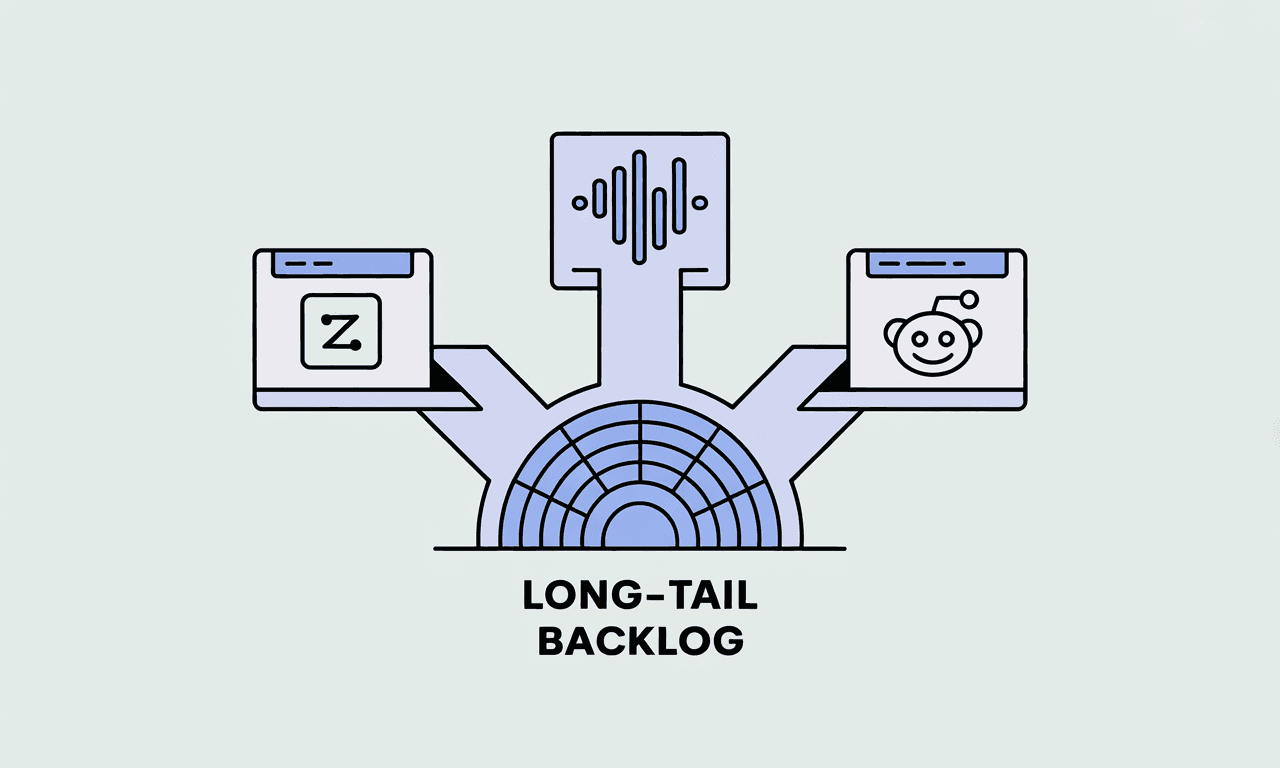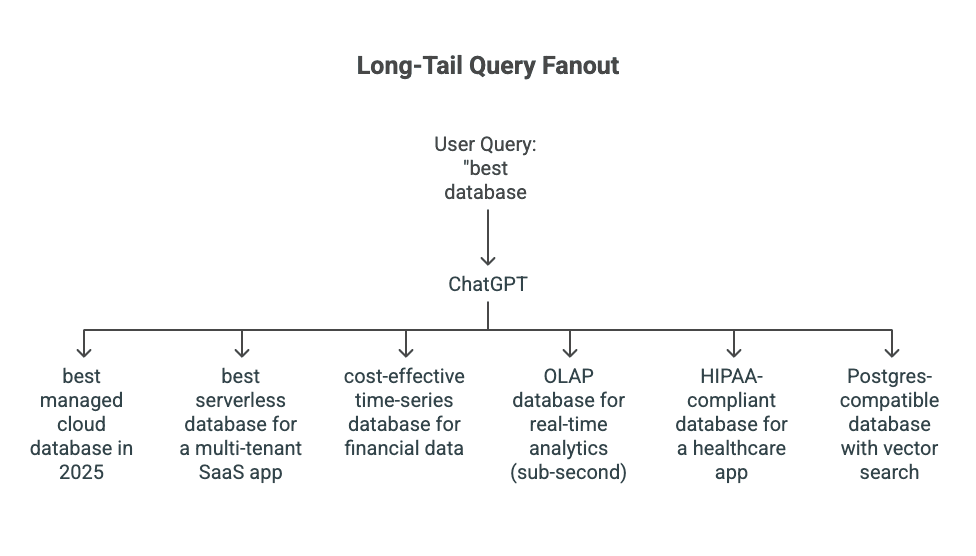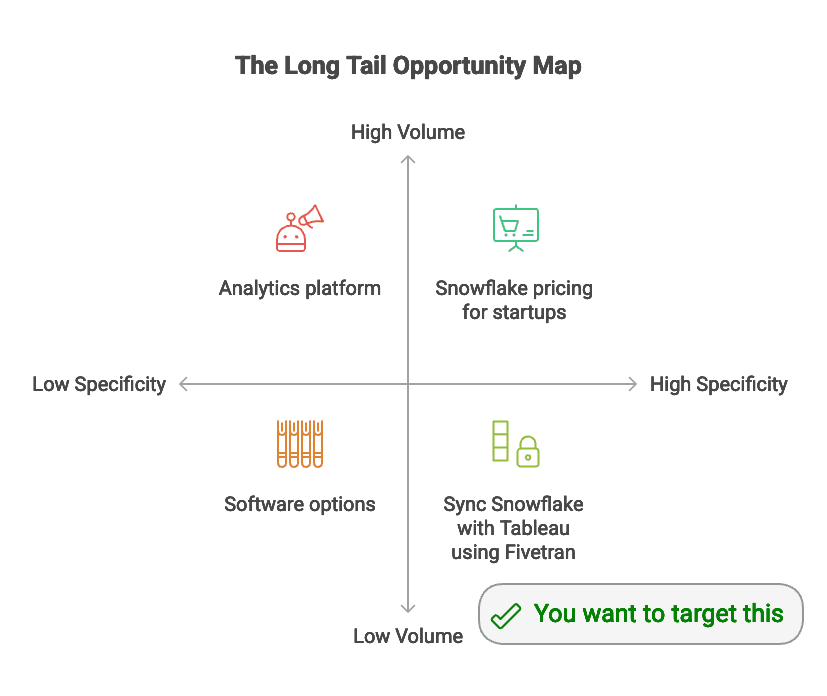Mastering the Long Tail for AI Search: A Guide to 25-Word Queries
Master your AI search optimization strategy by targeting long-tail queries. Learn our data-backed playbook to find and answer the 25-word questions that win citations.
Prerequisites

As detailed in our Ultimate Guide to AEO, the way people search for information is changing.
The data is conclusive: while Google searches average just 6 words, ChatGPT queries average 25 words. This shift to 'The Long Tail Renaissance' means users are no longer searching for 'analytics tools'; they are inputting paragraph-long prompts describing their exact tech stack and business constraints.
Companies that optimize for the old 6-word world are becoming invisible. This guide details exactly how to find and win these high-intent, 25-word queries.
Key Takeaways
- The Query Length Shift: AI search queries average 25 words, a more than four-fold increase compared to just 6 on Google. This is a fundamental and permanent change in user behavior.
- The New Long Tail is High Volume: While an individual 25-word query has negligible search volume in traditional SEO tools, the combined volume of its thousands of variations in AI search is massive. This collective volume represents the bulk of the opportunity.
- The Opportunity Map: The most significant wins are found in what can be called "Quadrant 4," which contains high-specificity, historically low-volume queries. In this quadrant, a company can be the only credible answer, leading to near-100% citation rates in AI responses.
- Source from Your Customers: The best long-tail questions are not found in keyword tools. They are hidden in plain sight within support tickets, sales call recordings, and community forums where customers describe their specific problems in their own words.
The Data: Why 25-Word Queries Are the New Normal
The evidence for this query change goes beyond stories and observations. Hard data confirms that AI platforms have fundamentally changed how people search. This dramatic increase reflects more than just interface differences. It signals a complete change in user behavior.
The psychology behind this shift is simple. Conversational interfaces remove the mental work of translating thoughts into keywords. Users no longer need to guess which terms might bring relevant results. Instead, they describe their actual situation: "What CRM works best for a 50-person B2B sales team selling enterprise software with 6-month sales cycles that needs native integration with our existing HubSpot marketing automation and Zendesk support system?" The AI rewards this detail with precisely tailored answers, encouraging the behavior.
Traditional SEO metrics are already showing this disruption. According to industry analysis, search impressions have grown 49% since Google launched AI Overviews, yet click-through rates have dropped 30%. More concerning for traditional SEO strategies: when AI Overviews appear, the top organic result experiences a 34.5% decline in CTR. The message is clear. Ranking first no longer guarantees traffic. Being cited within the AI response itself has become the new target.
Marketing teams must abandon their keyword-focused mindset and embrace question-focused content strategies. The era of competing for two-word phrases has ended. Success now depends on answering the complex, context-rich questions that AI users naturally ask.
The Long Tail Renaissance: Why This Changes Everything for B2B
The long tail concept has existed in digital marketing for decades, but AI search has transformed it from a minor strategy into the main approach. Previously, targeting a query with 10 monthly searches seemed economically pointless. Marketing teams focused on head terms with thousands of searches, accepting fierce competition as the price of volume.
AI search flips this calculation completely. Those 10-search queries don't exist alone. They represent one variation among hundreds of ways users express the same need. "ClickHouse vs Snowflake for IoT analytics" might show zero searches in SEMrush, but combine it with "comparing ClickHouse and Snowflake for time-series sensor data," "which data warehouse handles high-frequency IoT ingestion better," and countless other variations, and the combined volume becomes substantial.
B2B companies benefit especially from this shift. Consumer queries might lengthen from "running shoes" to "comfortable running shoes for flat feet under $150," but B2B queries explode in complexity. Enterprise buyers must consider existing infrastructure, compliance requirements, integration capabilities, team expertise, budget constraints, and stakeholder preferences. A typical B2B evaluation query might read: "Which data warehouse solution offers the best price-performance for a Series B fintech startup processing 10TB daily with existing Kafka infrastructure, DBT transformations, and a team familiar with PostgreSQL?"
This complexity creates competitive advantages. Established players optimized for "data warehouse" can't easily pivot to answer thousands of highly specific scenarios. Smaller companies that consistently address these precise use cases can dominate entire segments despite limited resources. They win not through domain authority but through relevance. They provide the exact answer to the exact question at the exact moment of need. Conversion rates from this perfectly aligned traffic consistently exceed generic keyword traffic.

The opportunity is clear, but execution requires finding and prioritizing these high-value queries.
The Long Tail Opportunity Map: A Framework for Prioritization
Strategic focus separates successful long-tail campaigns from scattered efforts. The Long Tail Opportunity Map provides a decision framework, plotting queries along two dimensions: Specificity (query precision) and Volume (traditional search metrics). This creates four distinct quadrants, each requiring different approaches.

-
Quadrant 1: High Volume, Low Specificity. Generic terms like "analytics platform" or "best CRM" live here. Massive search volume attracts every competitor with a marketing budget. Unless you're already dominant, avoid this quadrant. The ROI rarely justifies the investment required to compete.
-
Quadrant 2: High Volume, High Specificity. Queries like "Snowflake pricing for startups" or "Salesforce HubSpot integration" offer the best of both worlds. You get meaningful search volume with manageable competition. These form your content foundation, worthy of comprehensive pillar pages and ongoing optimization.
-
Quadrant 3: Low Volume, Low Specificity. Vague queries like "software options" or "business tools" lack both volume and clear intent. Users asking these questions aren't ready to buy and probably won't convert even if they find your content. Skip this quadrant entirely.
-
Quadrant 4: Low Volume, High Specificity. The hidden goldmine: "How to sync Snowflake with Tableau using Fivetran for daily marketing attribution reports" shows zero searches but represents exactly how AI users ask questions. Competition is nonexistent, intent is maximum, and combined volume across variations is significant.
Quadrant 4 deserves your primary attention. While individual queries seem insignificant, collectively they represent the majority of AI search traffic. More importantly, you can own these queries completely. No bidding wars, no link-building campaigns, no fighting algorithm updates. Just comprehensive answers to real questions. A single well-crafted piece addressing a Quadrant 4 query can drive more qualified leads than dozens of generic blog posts.
The challenge lies in finding these invisible queries before competitors recognize their value.
How to Find & Prioritize High-Impact Long-Tail Queries
Discovering Quadrant 4 opportunities requires abandoning keyword tools for customer intelligence. These queries don't appear in traditional SEO databases because they're too specific, too new, or too varied. Instead, look at the places where customers naturally express their challenges.
Source 1: Your Customers (The Ground Truth) Your existing customers and prospects are already telling you exactly what content to create. You just need to listen carefully.
-
Support Intelligence: Export your Zendesk or Intercom tickets and group them by topic. Each "How do I..." question represents content that could prevent future tickets while attracting similar prospects. Pay special attention to integration questions, edge cases, and complex workflows. These make excellent Quadrant 4 targets.
-
Sales Intelligence: Tools like Gong and Chorus capture the exact language prospects use during discovery calls. When a prospect asks, "Can your platform handle our specific situation where..." you've found a content opportunity. These recordings reveal not just what prospects need but how they describe those needs.
Source 2: Your Community (Public Intent) Online communities provide unfiltered access to your market's actual questions and concerns.
- Forums and Social Platforms: Monitor Reddit threads, Stack Overflow questions, LinkedIn discussions, and Discord servers where your audience gathers. Look for detailed problem descriptions, especially those marked "unanswered" or receiving lengthy discussion threads. These gaps in available information represent your content opportunities.
Source 3: Your Competitors (Reverse Engineering) Competitors' paid search campaigns reveal which problems they consider worth paying to solve.
- Paid Search Analysis: Export competitors' Google Ads keywords from SEMrush or similar tools. Transform these short keywords into long-tail questions using AI: "Take these keywords and generate 25-word questions that a [target persona] would ask when evaluating solutions." This reverse-engineering often reveals gaps competitors haven't addressed organically.
Prioritization Framework
Raw question lists need careful evaluation to identify highest-impact opportunities. Score each potential topic using this formula:
-
Intent-Value: Direct alignment with your product's core value proposition scores highest. Transactional intent beats informational intent.
-
Conversion-Potential: Estimate the lifetime value of a customer acquired through this query. Enterprise integration questions often score higher than general feature inquiries.
-
Effort: Consider content creation complexity, technical expertise required, and competitive density. Quick wins should jump to the front of your queue. These are high-impact questions you can answer well with existing knowledge.
With prioritized questions in hand, the next challenge is structuring answers for maximum AI visibility.
Content Architecture: Pillar Pages vs. Single Articles
The structural organization of your long-tail content significantly impacts its effectiveness in AI search. To rank for these granular 25-word queries without creating thousands of disconnected pages, you must use the Pillar-and-Cluster architecture.
As explained in our deep dive on Topical Authority, this model links specific 'cluster' pages back to a central hub. For long-tail AEO, your goal is to turn every specific user question (e.g., 'How to sync Snowflake with Tableau via Fivetran') into a dedicated cluster page that links back to your main 'Data Integration' pillar."
This architecture delivers multiple advantages for AI optimization:
-
Prevents Keyword Cannibalization: Without clear structural hierarchy, similar pages compete against each other, weakening ranking potential. The pillar-cluster model assigns distinct purposes, ensuring each page targets unique queries while supporting the overall topic authority.
-
Matches AI "Query Fan-Out": Complex AI queries trigger what experts call "query fan-out". The system breaks one question into multiple sub-queries. Your cluster pages provide ready answers for each component, dramatically increasing citation probability across the entire response.
Writing for AI Citations: The Comprehensive Answer Template
Converting topic expertise into AI-optimized content requires specific formatting and writing techniques. Every cluster page should follow this proven template:
-
Restate the Question as the H1: Mirror the user's query exactly in your headline. This creates immediate relevance signals for both users and AI systems scanning for answers.
-
Provide a Direct Answer Upfront: Your opening paragraph must directly answer the question without introduction. Think Wikipedia's opening sentences. You want immediate value delivery that can stand alone if needed.
-
Prioritize Facts Over Fluff: Every sentence should convey information. Replace "Our platform provides industry-leading integration capabilities" with "The platform connects via REST API, GraphQL, or native SDKs, supporting 47 specific third-party services including Salesforce, HubSpot, and Slack."
-
Use Structure for Readability: Create clear heading hierarchies that anticipate follow-up questions. Format specifications in tables, processes in numbered lists, and options in bulleted lists. Bold key terms and metrics. This structure helps AI systems extract precise information efficiently.
-
Implement Structured Data (Schema): Add schema markup for FAQs, how-tos, and articles. This metadata explicitly identifies your content's purpose and structure, improving AI comprehension.
-
Cover Edge Cases and Trade-offs: Address limitations honestly, discuss alternatives fairly, and acknowledge special circumstances. This balanced approach shows expertise while providing the nuance AI systems need for comprehensive answers.
-
Link to Related Questions: Create explicit connections between cluster pages and back to your pillar content. These links help both users and AI systems discover related information, increasing overall topic visibility.

Creating optimized content is only half the equation. Measuring its impact requires entirely new metrics.
Measuring Success: New Metrics for the AI Search Era
Traditional SEO metrics fail here. You need to track Citation Rate and Share of Answer. We cover the exact formulas and tools for these in our Definitive Guide to AI Share of Voice.
Once you have your tracking set up, structure your Long-Tail Performance Dashboard as follows:
Sample AEO Performance Dashboard
| Metric | Q1 Target | Q1 Actual | QoQ Change | Notes |
|---|---|---|---|---|
| Target Queries Tracked | 50 | 50 | - | Basket of Quadrant 4 queries |
| Citation Rate | 15% | 18% | +20% | Exceeded target for new content cluster |
| Share of Answer | 10% | 12% | +20% | Gaining ground on key competitor |
| Organic Clicks (Cited Pages) | -5% | -8% | - | Expected decline due to AIOs |
This measurement framework shifts focus from vanity metrics to business impact, providing clearer ROI demonstration for AI-focused content strategies.
Table: Traditional Long-Tail vs. AI Long-Tail Strategy
| Factor | Traditional SEO Approach | AI Search (AEO/GEO) Approach |
|---|---|---|
| Primary Source for Keywords | Keyword research tools (Ahrefs, SEMrush) | Customer data (support tickets, sales calls), community forums (Reddit) |
| Perceived Volume | Low (e.g., 10 searches/month), often ignored | High combined volume from thousands of unique variations |
| Content Goal | Rank a single page for a specific keyword | Become the cited source within an AI-generated answer |
| Competition Level | Low to moderate | Near-zero for highly specific "Quadrant 4" queries |
| Key Metric | Organic clicks, keyword ranking | Citation rate, brand mentions in AI answers, assisted conversions |
Table: Content Architecture Decision Matrix
| Criterion | Separate Granular Page | Pillar & Cluster Guide |
|---|---|---|
| Topic Complexity | Best for narrow, standalone topics | Superior for broad, complex topics with many sub-questions |
| Keyword Cannibalization Risk | High risk if topics are too similar | Low risk due to distinct focus for each page |
| Topical Authority Building | Minimal impact on overall site authority | High impact, signals deep expertise across an entire topic |
| AI Overview Eligibility | Can be cited for a single, direct question | Higher probability of citation for complex queries via "query fan-out" |
| Resource Investment | Lower upfront effort per page | Higher initial investment in strategy and content creation |
Conclusion
The evolution from keyword fragments to conversational queries marks a defining moment in digital marketing history. This isn't an optimization update or algorithm tweak. It's a complete reconstruction of how humans seek and find information online. Companies that recognize and adapt to this shift will capture the most valuable traffic available: buyers with specific needs, clear requirements, and high purchase intent.
Success in this new landscape belongs to those who embrace Quadrant 4. These are the highly specific, seemingly low-volume queries that competitors ignore. These questions, sourced directly from customer conversations and community discussions, represent the authentic voice of your market. By consistently answering them through a well-structured pillar-and-cluster architecture, you build the topical authority that AI systems trust and cite.
The path forward is clear and actionable. Start this week by examining your last ten support tickets containing integration or how-to questions. Apply the prioritization framework to identify which deserve immediate attention. Those tickets aren't just customer service issues. They're your roadmap to AI search success.
